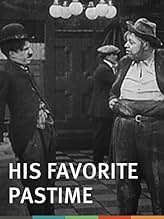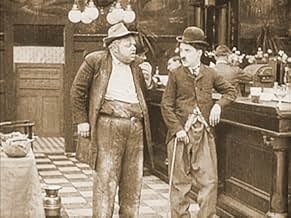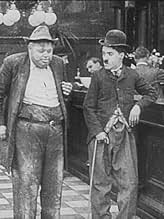NOTE IMDb
4,9/10
1,3 k
MA NOTE
Ajouter une intrigue dans votre langueA very plastered fella follows a pretty woman home, and proceeds to make a nuisance of himself.A very plastered fella follows a pretty woman home, and proceeds to make a nuisance of himself.A very plastered fella follows a pretty woman home, and proceeds to make a nuisance of himself.
- Réalisation
- Scénario
- Casting principal
Peggy Pearce
- Wife
- (as Velma Pearce)
Helen Carruthers
- Servant
- (non crédité)
Jess Dandy
- Minor Role
- (non crédité)
Hampton Del Ruth
- Drinker with Moustache
- (non crédité)
Billy Gilbert
- Shoeshine Boy
- (non crédité)
William Hauber
- Shoeshine Customer
- (non crédité)
- …
George Jeske
- Servant
- (non crédité)
Edgar Kennedy
- Tough Guy in Bar
- (non crédité)
Harry McCoy
- Bar Patron
- (non crédité)
Rube Miller
- Bar Patron
- (non crédité)
Avis à la une
Just as Babe Ruth struck out now and then, and George Gershwin hit the occasional sour note, Charlie Chaplin made a few comedies during his apprenticeship at Keystone that don't hold up all that well. In the better efforts we can detect a great talent struggling to emerge from the chaos, and there are good moments scattered about, while a couple of them (I'm thinking of The New Janitor and Caught in a Cabaret) are quite satisfying: nicely constructed films with funny gags and a story to tell. However, several of the Keystones -- and I say this as a lifelong Chaplin fan -- are a chore to sit through. Too many of them are burdened with an overload of silly histrionics and painful-looking slapstick violence, and those good moments are hard to find.
Well, I'd say the good moments are scarce indeed in His Favorite Pastime. The main problem is that Chaplin's character is so obnoxious: he looks like the Little Tramp, but sure doesn't act like him. Most of this film is set in a pub, and once Charlie's had a few shots he turns into a mean drunk. There's a vigorous workout involving a swinging door, and it's mildly amusing, but the routine lacks the finesse Chaplin would bring to such business later on, in far better comedies such as The Cure. Moreover, in his later work the characters taking the brunt of the violence usually deserved it. Here, by contrast, when an inoffensive washroom attendant (a white actor wearing black-face makeup) holds out his hand for a tip, Charlie drops a lighted match instead of a coin and burns the man's hand. Ouch! Later, thoroughly blotto, Charlie follows a pretty woman home, walks right into her house, and makes a pass at her. Actually, on his first attempt, he accidentally makes the pass at her 'colored' maid (again a white performer in black-face), and is horrified when he realizes his mistake -- a very unusual racial gag in Chaplin's work, and another strike against this film. Really the only worthwhile moment is a nice demonstration of physical dexterity, when Charlie falls over a banister, lands on a sofa, and then casually lights a cigarette.
There are a couple points of minor interest in His Favorite Pastime concerning the cast: the opening sequence in the saloon features Chaplin's Keystone colleague Roscoe Arbuckle, so heavily disguised as a shabby drunk that he's barely recognizable. Where laughs are concerned nothing much comes of the scene, but it's interesting to note Arbuckle's resemblance to Orson Welles in his grizzled makeup for A Touch of Evil, made many years later. Also, the society lady Charlie follows home is played by an actress variously known as Peggy Pearce and Viola Barry, who reportedly was romantically involved with Chaplin for a brief time during his stint at Keystone. Here she isn't given much to do, but she can be seen to better advantage opposite Lillian Gish in D. W. Griffith's Biograph drama of 1913, The Mothering Heart. That short drama, by the way, holds up considerably better than this comedy.
Well, I'd say the good moments are scarce indeed in His Favorite Pastime. The main problem is that Chaplin's character is so obnoxious: he looks like the Little Tramp, but sure doesn't act like him. Most of this film is set in a pub, and once Charlie's had a few shots he turns into a mean drunk. There's a vigorous workout involving a swinging door, and it's mildly amusing, but the routine lacks the finesse Chaplin would bring to such business later on, in far better comedies such as The Cure. Moreover, in his later work the characters taking the brunt of the violence usually deserved it. Here, by contrast, when an inoffensive washroom attendant (a white actor wearing black-face makeup) holds out his hand for a tip, Charlie drops a lighted match instead of a coin and burns the man's hand. Ouch! Later, thoroughly blotto, Charlie follows a pretty woman home, walks right into her house, and makes a pass at her. Actually, on his first attempt, he accidentally makes the pass at her 'colored' maid (again a white performer in black-face), and is horrified when he realizes his mistake -- a very unusual racial gag in Chaplin's work, and another strike against this film. Really the only worthwhile moment is a nice demonstration of physical dexterity, when Charlie falls over a banister, lands on a sofa, and then casually lights a cigarette.
There are a couple points of minor interest in His Favorite Pastime concerning the cast: the opening sequence in the saloon features Chaplin's Keystone colleague Roscoe Arbuckle, so heavily disguised as a shabby drunk that he's barely recognizable. Where laughs are concerned nothing much comes of the scene, but it's interesting to note Arbuckle's resemblance to Orson Welles in his grizzled makeup for A Touch of Evil, made many years later. Also, the society lady Charlie follows home is played by an actress variously known as Peggy Pearce and Viola Barry, who reportedly was romantically involved with Chaplin for a brief time during his stint at Keystone. Here she isn't given much to do, but she can be seen to better advantage opposite Lillian Gish in D. W. Griffith's Biograph drama of 1913, The Mothering Heart. That short drama, by the way, holds up considerably better than this comedy.
In 1914, Charlie Chaplin began making pictures. These were made for Mack Sennett (also known as "Keystone Studios") and were literally churned out in very rapid succession. The short comedies had very little structure and were completely ad libbed. As a result, the films, though popular in their day, were just awful by today's standards. Many of them bear a strong similarity to home movies featuring obnoxious relatives mugging for the camera. Many others show the characters wander in front of the camera and do pretty much nothing. And, regardless of the outcome, Keystone sent them straight to theaters. My assumption is that all movies at this time must have been pretty bad, as the Keystone films with Chaplin were very successful.
The Charlie Chaplin we know and love today only began to evolve later in Chaplin's career with Keystone. By 1915, he signed a new lucrative contract with Essenay Studios and the films improved dramatically with Chaplin as director. However, at times these films were still very rough and not especially memorable. No, Chaplin as the cute Little Tramp was still evolving. In 1916, when he switched to Mutual Studios, his films once again improved and he became the more recognizable nice guy--in many of the previous films he was just a jerk (either getting drunk a lot, beating up women, provoking fights with innocent people, etc.). The final evolution of his Little Tramp to classic status occurred in the 1920s as a result of his full-length films.
This short featured Chaplin and Fatty Arbuckle. Both were major early comedy stars. Unfortunately, neither comedian looked terribly funny or interesting in this short about jealousy. Too bad, as I had hoped for so much more from these stars.
The Charlie Chaplin we know and love today only began to evolve later in Chaplin's career with Keystone. By 1915, he signed a new lucrative contract with Essenay Studios and the films improved dramatically with Chaplin as director. However, at times these films were still very rough and not especially memorable. No, Chaplin as the cute Little Tramp was still evolving. In 1916, when he switched to Mutual Studios, his films once again improved and he became the more recognizable nice guy--in many of the previous films he was just a jerk (either getting drunk a lot, beating up women, provoking fights with innocent people, etc.). The final evolution of his Little Tramp to classic status occurred in the 1920s as a result of his full-length films.
This short featured Chaplin and Fatty Arbuckle. Both were major early comedy stars. Unfortunately, neither comedian looked terribly funny or interesting in this short about jealousy. Too bad, as I had hoped for so much more from these stars.
His Favorite Pastime is only about 16 minutes long, yet I found it so boring I nearly fell asleep. The plot makes even less sense than usual, and Chaplin seems to be sleepwalking through the comedy.
There are a few interesting gags, such as The Tramp vs. a pair of saloon doors, and later, the Tramp riding the front of a streetcar, but nothing really gels in this early silent Chaplin. His drunk act was starting to get old by this point, and in fact the character he plays here is little different than the character he played in his previous film, Tango Tangles, except that the comedy in the earlier short is far superior.
My advice: unless you have a desire to see every film Chaplin made, good or bad, skip this one.
There are a few interesting gags, such as The Tramp vs. a pair of saloon doors, and later, the Tramp riding the front of a streetcar, but nothing really gels in this early silent Chaplin. His drunk act was starting to get old by this point, and in fact the character he plays here is little different than the character he played in his previous film, Tango Tangles, except that the comedy in the earlier short is far superior.
My advice: unless you have a desire to see every film Chaplin made, good or bad, skip this one.
It appears this is unpopular, even compared to other early Chaplins.
I found it funnier and more advanced than a number of Chaplin's films from this period.
It suffers compared to later films of his, of course, because I find these early films are rather primitive. However, several of his films before and after this are less funny and less interesting.
Chaplin's drunk act is excellent throughout. Fatty Arbuckle does a decent performance too. The sequence where Charlie fights with a saloon toilet door is funny and much copied. When he jumps onto a moving vehicle it is well done and interesting,
All in all, not a bad little film.
I found it funnier and more advanced than a number of Chaplin's films from this period.
It suffers compared to later films of his, of course, because I find these early films are rather primitive. However, several of his films before and after this are less funny and less interesting.
Chaplin's drunk act is excellent throughout. Fatty Arbuckle does a decent performance too. The sequence where Charlie fights with a saloon toilet door is funny and much copied. When he jumps onto a moving vehicle it is well done and interesting,
All in all, not a bad little film.
In another disappointing short comedy, Charlie Chaplin once again plays the standard, belligerent drunk, drinking himself into oblivion and then stumbling around this run-of-the-mill slapstick comedy. There are some mildly interesting items, such as the fact that the altogether unamusing but watchable opening scene features Chaplin and Keystone colleague Fatty Arbuckle as fellow drinkers in the pub, taking beers away from each other and gradually getting drunker and drunker, as well as the fact that this is one of the earliest, maybe even the origin, of one of Chaplin's gags that he would later perfect and use with great success, the lighting of the match on the seat of his pants. Other than that, there is not much else of note here.
The comedy of the film is really nonexistent, which is not to say that it is entirely bad, just a failed experiment. The obnoxious drunk has long since lost its appeal, if it ever had any, and I imagine even audiences back in 1914 must have been getting tired of it. The film features some of the most blatant racism of any of his films, although certainly not the last (remember the three minds with but a single thought from A Day's Pleasure?). At one point late in the film, Charlie follows a woman right into her home and hits on her, and is then horrified when he realizes that she is black. He also drops a lighted match into a black man's hand when he holds it out for a tip, which is exactly the kind of thing that makes this drunken character so dislikable.
Most of the rest of the film is composed of people pushing and shoving other people around and hitting each other, and ultimately it seems that Chaplin simply uses drunkenness in the film to serve as a reason to stagger around and hit people and get in fights with swinging doors and fall over stairway banisters and such. The plot outline on the IMDb says "A very plastered fella follows a pretty woman home, and proceeds to make a nuisance of himself." And sadly, there's not much difference between watching the film and reading that one line.
The comedy of the film is really nonexistent, which is not to say that it is entirely bad, just a failed experiment. The obnoxious drunk has long since lost its appeal, if it ever had any, and I imagine even audiences back in 1914 must have been getting tired of it. The film features some of the most blatant racism of any of his films, although certainly not the last (remember the three minds with but a single thought from A Day's Pleasure?). At one point late in the film, Charlie follows a woman right into her home and hits on her, and is then horrified when he realizes that she is black. He also drops a lighted match into a black man's hand when he holds it out for a tip, which is exactly the kind of thing that makes this drunken character so dislikable.
Most of the rest of the film is composed of people pushing and shoving other people around and hitting each other, and ultimately it seems that Chaplin simply uses drunkenness in the film to serve as a reason to stagger around and hit people and get in fights with swinging doors and fall over stairway banisters and such. The plot outline on the IMDb says "A very plastered fella follows a pretty woman home, and proceeds to make a nuisance of himself." And sadly, there's not much difference between watching the film and reading that one line.
Le saviez-vous
- AnecdotesThis film is among the 34 short films included in the "Chaplin at Keystone" DVD collection.
Meilleurs choix
Connectez-vous pour évaluer et suivre la liste de favoris afin de recevoir des recommandations personnalisées
Détails
- Date de sortie
- Pays d’origine
- Sites officiels
- Langues
- Aussi connu sous le nom de
- Charlie Is Thirsty
- Société de production
- Voir plus de crédits d'entreprise sur IMDbPro
- Durée16 minutes
- Couleur
- Mixage
- Rapport de forme
- 1.33 : 1
Contribuer à cette page
Suggérer une modification ou ajouter du contenu manquant

Lacune principale
By what name was Charlot est trop galant (1914) officially released in Canada in English?
Répondre

























